Aloe Veras are native to the desert regions of the Arabian Peninsula. They are easy to care for and endurable plants. Though hardy succulent, they are sensitive to extremely high or low temperatures, which can be unfavorable to their development.
Aloe Vera will thrive when the temperature ranges between 55-80°F. Although Aloe Vera can tolerate a wide range of temperatures, extremely low or high temperatures will result in the wilting of the plant. Provide them shade and protect them from cold drafts when the temperature is unfavorable.
In the winters, if the temperature drops below 50°F, the plant will need protection. Sometimes, they even stay semi-dormant if the temperature is too low in the winters.
If you want to know the temperature tolerance of Aloe Vera to keep them healthy, this guide will help you to understand their required temperature.
Along with that, we will also share information about maintaining their ideal temperature during extreme conditions.
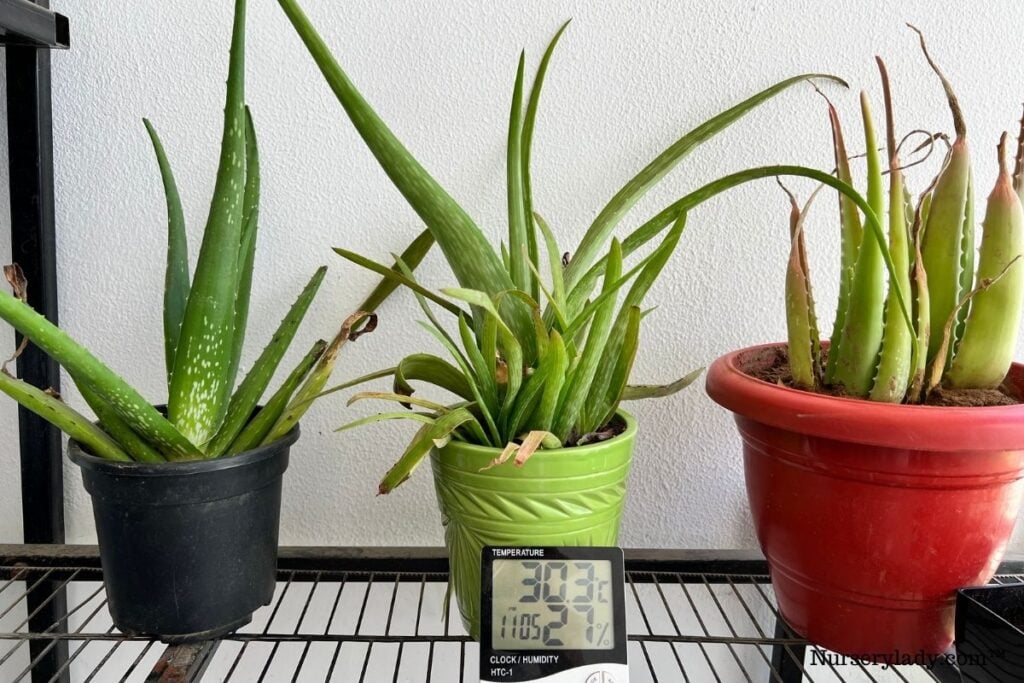
What is the ideal temperature for the Aloe Vera?
Since Aloe Vera thrives in desert areas in warm temperatures, they can tolerate warmth, but cold is their enemy.
Temperature bothers outdoor Aloe veras more than indoor ones.
Indoors, you can control the temperature in various ways.
But it is tough the temperatures outdoors.
Even with proper protection, the plant can experience issues.
So, if you are planting Aloe vera directly in the ground, you need to know the temperature of your region in different seasons.
However, you can always bring potted Aloe veras inside during harsh weather.
As a rule of thumb, Aloe Vera thrives best when the temperature is between 55-80°F.
Letting them have the right temperature depends on your region and whether you want to grow them indoors or outdoors.
They will grow best at such temperatures during spring and summer.
If you live in regions that have warm and sunny days, your Aloe Veras will thrive outside.
Warm temperature and full sun will also help them grow faster and bigger.
Aloe Vera will grow best in the summers when the temperature stays between 70-80°F.
Aloe Veras will go dormant during the hottest summer days, i.e., when the temperature rises above 80-90°F.
You have to protect the Aloe vera if they are outdoors.
If you live in zones 8 to 11, you can keep Aloe Veras outdoors as these zones won’t receive extremely low temperatures.
But, if your region receives frost, you must grow Aloe vera in pots and bring them indoors.
They won’t tolerate temperatures below 50°F.
However, some cold-hardy Aloe Veras can endure temperatures around 20-30°F.
Sometimes, Aloe Veras even goes dormant in the winter if the temperature is too low.
It is rare, though.
Summer dormancy is natural.
Aloe Veras will remain healthy during winters when the temperature ranges between 50-60°F.
How hot is it too hot for Aloe Vera plants?
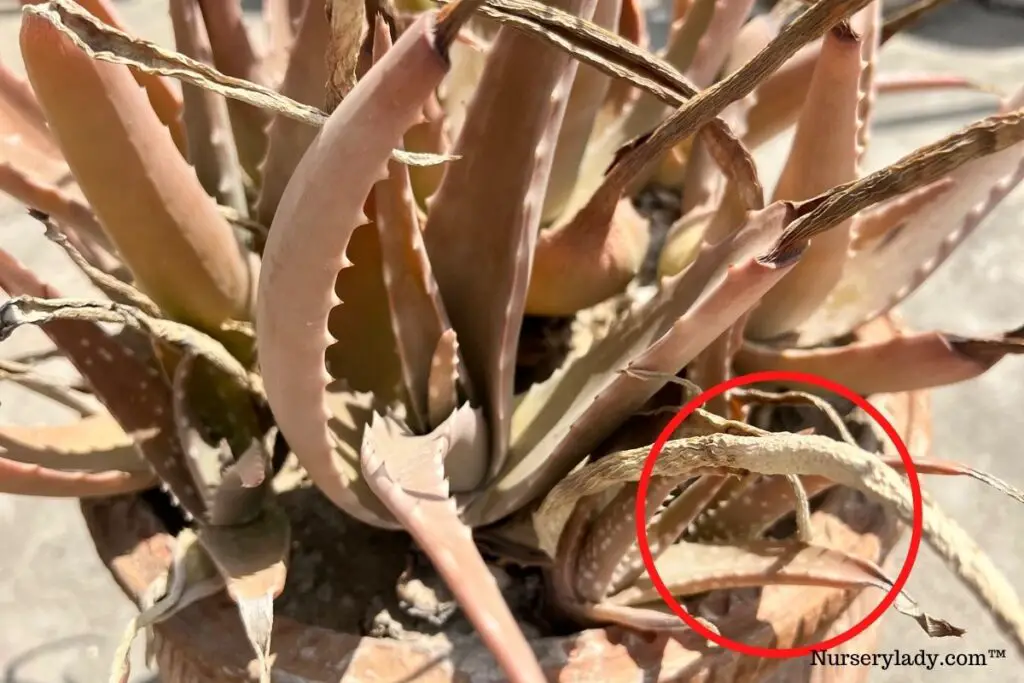
The warmth of the summer season is good for Aloe Veras.
Since they belong to the warm desert regions, Aloes will grow actively during the summers.
But, they will only grow well if the temperature stays within 70-80°F.
If it goes beyond 80°F to 90°F, the plant will go dormant.
The indoor plants may not go dormant as the temperature is less inside.
You have to take care of the outdoor Aloes during the summers, especially from the harsh sunlight.
If exposed to direct sunlight, Aloe Veras will get sunburned.
Along with the high temperatures, the plant’s surroundings will have much higher temperatures while standing under the direct sun.
When exposed to such high temperatures and sunlight, the plant will first turn red.
Then brown patches will appear on the leaves, indicating sunburn.
How to take care of Aloe Veras in high temperatures during summer?
It will be fine if the temperature remains within 70-80°F during the summers.
They used to grow well around warm temperatures in their natural habitat, so they will enjoy growing at such temperatures.
But, if the temperature goes higher, the plant will get dormant.
You have to take care of them so that they don’t suffer.
Looking for gardening supplies? We have tested 100's of products before recommending them to you guys. Check out our best pick below:
| Image | Gardening Supplies | Best Price? |
|---|---|---|
 Top
Top Top
Top | Raised Garden Bed Kit | Check On Amazon |
 | XLUX Soil Moisture Meter, Plant Water Monitor, Soil Hygrometer Sensor for Gardening, Farming, Indoor and Outdoor Plants, No Batteries Required | No Results |
 Top
Top Top
Top | 82 Pcs Garden Tools Set and Extra Succulent Tools Set | Check On Amazon |
 | Joeys Garden Expandable Garden Hose with 8 Function Hose Nozzle, Lightweight Anti-Kink Flexible Garden Hoses, Extra Strength Fabric with Double Latex Core, (50 FT, Black) | No Results |
 Top
Top Top
Top | Dual Chamber Compost Tumbler | Check On Amazon |
 Top
Top Top
Top | Sunnyglade Plant Stakes | Check On Amazon |
 Top
Top Top
Top | Organic Cold Pressed Neem Seed Oil | Check On Amazon |
 Top
Top Top
Top | Mighty Mint Gallon :-Insect and Pest Control Peppermint Oil | Check On Amazon |
 Top
Top Top
Top | Scotts DiseaseEx Lawn Fungicide | Check On Amazon |
 Top
Top Top
Top | Jacks Classic 20-20-20 All Purpose Fertilizer | Check On Amazon |
 Top
Top Top
Top | 30,000 Seeds Pollinator Attracting Wildflower Mixture | Check On Amazon |
 Top
Top Top
Top | Survival Vegetable Seeds Garden Kit-Over 16,000 Seeds | Check On Amazon |
Shading nets or curtains
Shading nets are more important for the outside Aloe Veras standing under the full sun.
The high temperature accompanied by harsh heat will not only burn the Aloe Veras but will also deteriorate their health.
There will be brown patches all over.
Put transparent shading nets over the planting site to filter the direct sunlight.
It will give them mild and soft sunlight and save them from the harsh sun.
Make sure you don’t deprive them of light by completely shading the area.
That will give rise to other issues.
Bring them a few feet back from the window if your indoor plants are placed near the south or west-facing windows.
Put on sheer curtains to create partial shade. It will keep the plants from burning.
Also read: What Kind Of Light For Aloe Vera Plants? (Full sun, Shade, Or Partial Light?)
Water carefully
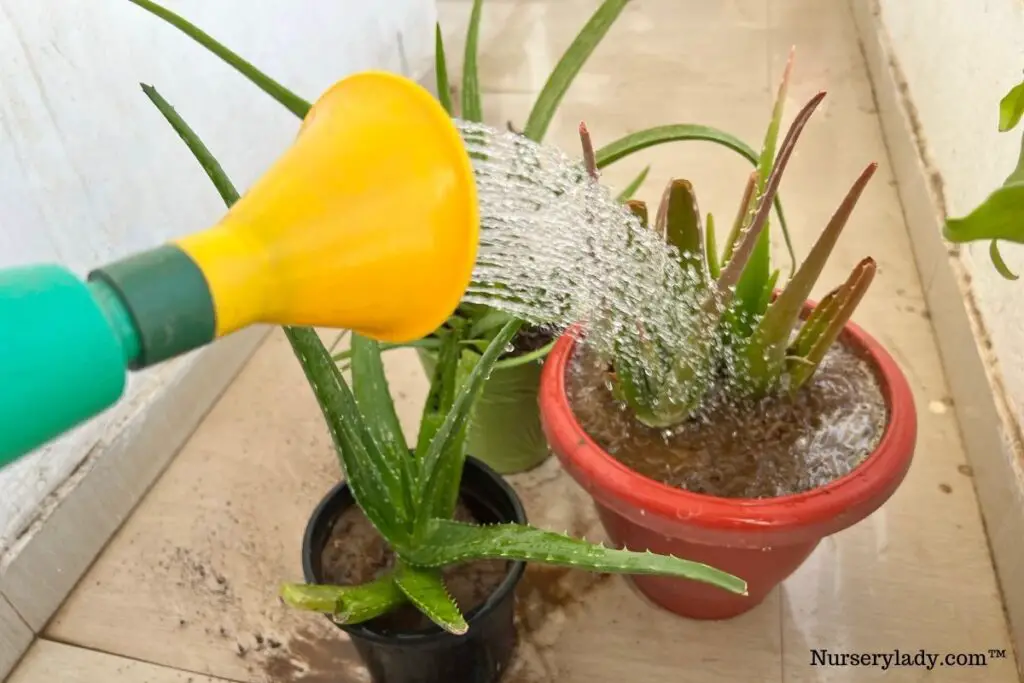
If the temperature stays within 80°F, you can water your plant once every 1-2 weeks.
Under the sun, they will require more water to keep the soil moist, the plant hydrated, and roots cool.
Aloe Veras will go dormant if the temperature rises above 80-90°F.
If the plant is dormant, it is better to avoid watering.
However, you can water them a bit only the keep the soil evenly moist.
Always check the moisture.
When the top 2-3 inches are dry, water them slightly.
Always check the soil from time to time and allow the soil to dry before watering.
Also read: How To Water Aloe Vera Plant? (How often, Summer, Winter)
Shift the container plants indoors or to a shady area
If your plant is in a pot and the outside temperature seems unbearable, you can shift them to a shady area or take them indoors.
Indoors, you can control and keep the surrounding temperature ideal for their growth, i.e., within 70-80°F.
Also, during normal temperature days, keep the indoor plants away from heaters, radiators, or fireplaces.
These areas will have a very hot and high temperature.
Fertilizing is good, but not when Aloes are dormant
Fertilize if the temperature is within 70 to 80°F.
Since it will be averagely warm, fertilizing can make them grow a little faster.
But don’t do it if the plant is dormant. Avoid it if you are unsure about it.
How cold is too cold for Aloe Vera plants?
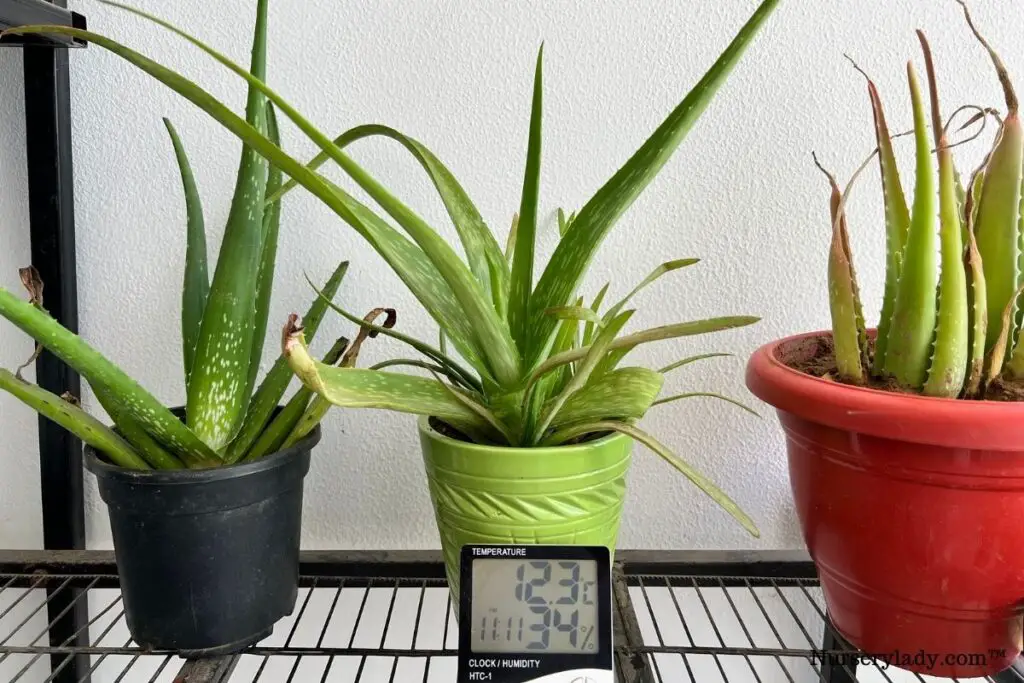
Although Aloe Veras can tolerate warmth to some extent, they will not tolerate cold temperatures.
However, cool winter is fine, but frosty winter is their death.
Aloe Vera can grow outside if your living region has mild winters.
Aloes will grow well if the temperature stays within 50-60°F.
They cannot tolerate it if the temperature drops below 40°F.
If you belong to the region getting such low temperatures, you must grow them indoors.
If you insist on keeping them outdoors for good sunlight, grow them in containers so that you can bring them inside at night in the winter.
There are some varieties of cold-hardy Aloe Veras that can tolerate cold temperatures.
Plants like Aloe Aristata and Aloe Broomii can tolerate low temperatures as near as 20°F to 25°F.
You can leave the Aloe Veras outside so that they can receive enough sunlight during the day.
It will keep them warm.
But don’t forget to shift them indoors at night.
Indoors, it is not only the weather responsible for cold.
If kept near air conditions or fans, that too can give them cold shock and injure them.
How to protect the Aloe Veras from the cold?
As long as the Aloe Veras has a temperature ranging between 50°F to 60°F during the winters, they will not need much protection.
However, some care is needed to keep them from suffering from cold.
Since they love warmth, cold temperature is their foe.
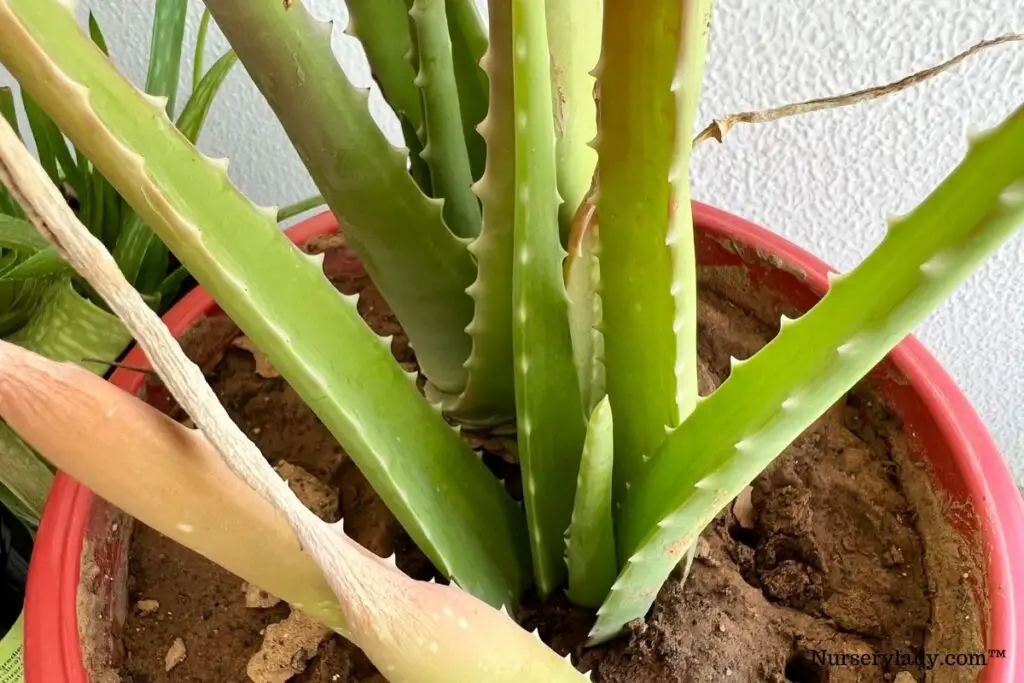
You can keep Aloes outside in zones 8 to 11
Aloe Vera can be kept outside if your region belongs to zones 8 to 11.
These regions don’t receive too much cold like the lower zones, for example, zones 3 to 5.
Let them have daily 5 to 6 hours of direct sunlight
Ensure that Aloe Vera receives 5-6 hours of sunlight per day.
Since the sun levels are low during the winters, let Aloe Vera receive direct sunlight.
It will warm them up.
For indoor Aloe Veras, keep the plant near a south or west-facing window sill to let them have direct sunlight for some hours.
The warmth from the sun will keep them good.
But, place them a few feet back so the cold winds can’t injure them.
Letting them have this sunlight will increase their surrounding temperature to some extent, keep them warm and maintain the temperature they need in the winters.
Mulch the soil with stones
You can add some pebbles or stones to the soil surface.
It will trap the warmth and prevent the cold temperature from reaching the roots.
Reduce watering and don’t fertilize
Don’t bother them with frequent watering or fertilizers.
Check the soil from time to time and water only when the soil has dried.
Don’t water if your plant got slight frostbite.
They will receive more cold than the indoors.
Always check the soil before watering. It will keep them from overwatering, root rot, leaf rot, etc.
Also read: Does Aloe Vera Need Fertilizer? (How Much, How Often+Best Pick)
Use well-drained soil
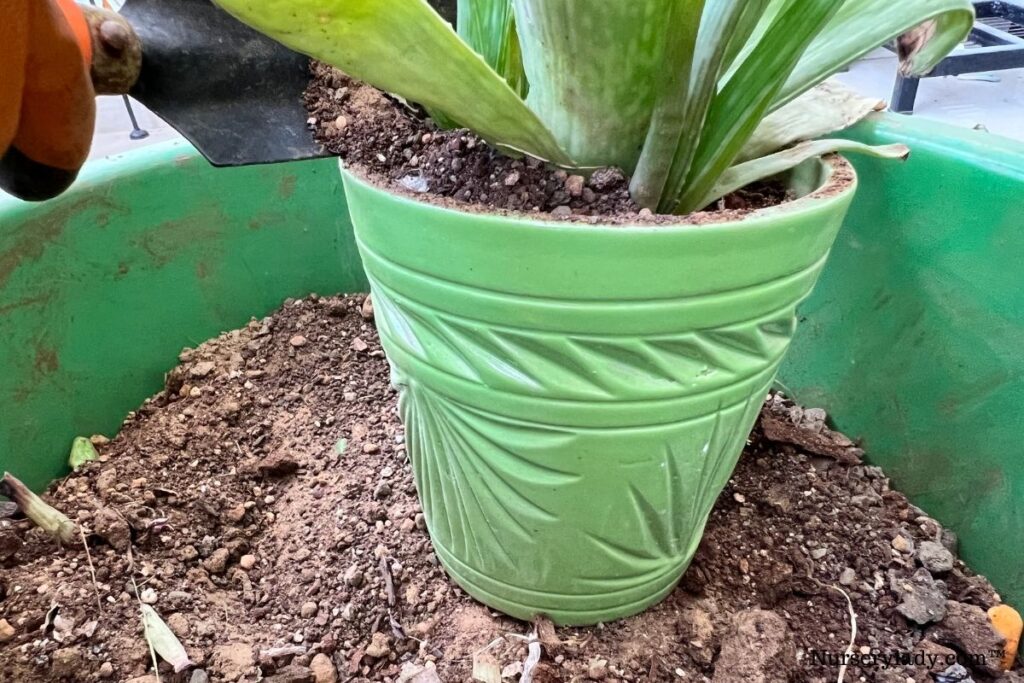
Using fast-draining soil is very important for Aloe Veras, especially during the winters.
Aloe Veras should be kept almost dry, but sometimes, you have to water them to keep them hydrated.
A well-drained soil can help drain the water and dry the soil faster.
It will also keep the plant from suffering overwatering and other types of rot.
Take them indoors during frost and keep them away from cold rooms
If the temperature drops below 40°F, bring Aloe Veras inside.
If your region receives frost, grow Aloes in containers to shift them inside the house.
If you grow Aloe Vera indoors, do not keep Aloe Veras close to air conditioners or fans, whether it is summer or any other season.
Also, keep them some feet back from the open windows.
Also read: What Type Of Soil For Aloe Vera Plant? (+Ideal Soil Mix)
Use frost clothes
Sometimes, unexpected frost can be dangerous for Aloes, especially the outdoor ones.
In such a case, cover the plant with a cotton blanket to prevent the frost from touching the plant.
You can also use frost cloths.
These are breathable and specially designed for all succulents.
It will keep them warm and prevent the cold temperature from reaching the plant tissues or roots.
While using these clothes or blankets, create a border or frame so that these clothes don’t touch the plant or fall over it.
Final thoughts
Aloe Veras grow well when kept around temperatures ranging between 55-80°F. In the summers, try to maintain their surrounding temperature around 70-80°F.
If the temperature rises beyond this range, they will go dormant. Water carefully. Check the soil from time to time and water only if the soil gets dry.
In the winters, within 50-60°F is good for them. At such temperatures, you can keep the outside. But lower than 40°F is harmful to them.
You must bring them indoors. For the ground plants, put on frost clothes so that the frost cannot touch them. Don’t water the outside Aloes.
Indoors, water sparingly, and keep the growing medium almost dry. Avoid areas near air conditioners, heaters, radiators, and fireplaces.
Reference: NCBI, New York Botanical Garden, University of New Hampshire, University of Florida, Wikipedia.

hi Richa
will allo vera stand very hot summers like in the Emeriates? temperature will go daily above 50 centigrate, or 122 farnhiet
thanks
I suggest providing share during the day and only allowing morning 1-2 hours of sun for best results.